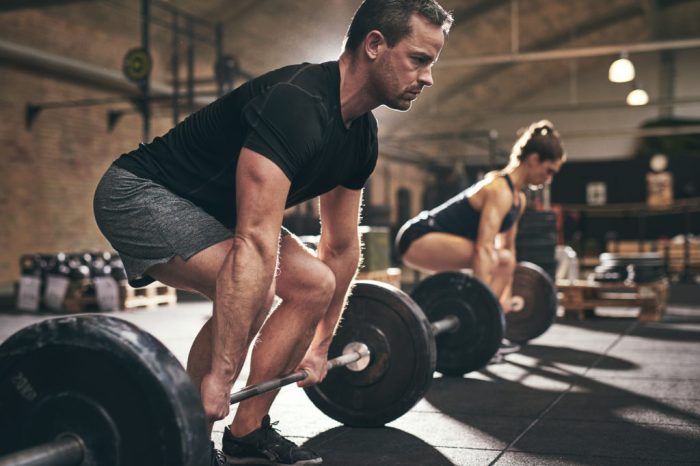Best weight lifting program for muscle gain – Discover the ultimate guide to building muscle mass effectively with the best weight lifting program tailored to your fitness journey. This comprehensive resource provides a roadmap for achieving your muscle-building goals, empowering you with the knowledge and strategies to transform your physique.
Our expert insights and evidence-based recommendations will guide you through every aspect of weight lifting for muscle gain, from program selection to nutrition and recovery. Get ready to unlock your muscle-building potential and witness the incredible results that await you.
Exercise Selection

Selecting the right exercises is crucial for maximizing muscle growth. Focus on compound exercises that work multiple muscle groups simultaneously, promoting greater hormonal response and overall efficiency.
Upper Body Exercises
- Barbell Bench Press:Targets chest, triceps, and shoulders. Lie on a bench with a barbell resting on your chest. Press the barbell up to full extension, then lower it back to your chest.
- Dumbbell Flyes:Isolates the chest. Lie on a bench with dumbbells held at chest level. Lower the dumbbells out to the sides, then bring them back together at the top.
- Overhead Press:Targets shoulders, triceps, and upper chest. Stand with a barbell or dumbbells held at shoulder height. Press the weight overhead until your arms are fully extended.
- Pull-Ups:Primarily works the back, but also engages the biceps and forearms. Hang from a bar with your palms facing you. Pull yourself up until your chin is above the bar, then lower back down.
Lower Body Exercises
- Barbell Squat:Targets quads, glutes, and hamstrings. Stand with your feet shoulder-width apart, holding a barbell on your shoulders. Lower your body by bending your knees and hips, then return to the starting position.
- Leg Press:Similar to the squat, but allows for greater isolation of the quads. Sit in a leg press machine and place your feet on the platform. Push the platform away from you, extending your legs.
- Romanian Deadlift:Primarily targets the hamstrings and glutes. Stand with your feet hip-width apart, holding a barbell in front of your thighs. Hinge at your hips, keeping your back straight, and lower the barbell down towards the ground.
- Calf Raises:Isolates the calf muscles. Stand on a raised platform and lift yourself up onto your toes, then lower back down.
Core Exercises
- Plank:Strengthens the entire core. Hold a position with your forearms on the ground and your body in a straight line from head to heels.
- Russian Twists:Targets the obliques. Sit on the floor with your knees bent and your feet elevated. Hold a weight in front of your chest and twist your torso from side to side.
Set and Rep Schemes

The number of sets and repetitions you perform in your workouts plays a crucial role in muscle growth. The optimal ranges for these variables depend on your fitness level and training goals. Let’s explore how to adjust these parameters for maximum muscle building.
Set Ranges
For beginners, it’s recommended to start with 2-3 sets per exercise. As you progress, you can gradually increase the volume by adding more sets. Experienced lifters may perform up to 5-6 sets per exercise to stimulate maximal muscle growth.
Rep Ranges
The optimal rep range for muscle growth is typically between 8-12 repetitions. This range allows you to lift a weight that challenges your muscles without compromising form or risking injury. Beginners should start with higher reps (10-12) to focus on technique and gradually transition to lower reps (8-10) as they become stronger.
The Significance of Rest and Recovery for Muscle Growth

Rest and recovery are essential components of any muscle-building program. During exercise, muscle fibers are broken down and damaged. Rest allows these fibers to repair and rebuild, resulting in muscle growth. Adequate sleep, nutrition, and hydration are also crucial for muscle recovery and growth.
Rest Periods Between Sets and Exercises
The duration and intensity of rest periods between sets and exercises can impact muscle growth. Short rest periods (30-60 seconds) promote strength and power gains, while longer rest periods (2-3 minutes) allow for greater muscle recovery and hypertrophy. The intensity of the exercise should also be considered when determining rest periods.
Heavy lifting requires longer rest periods than lighter weights.
Recovery Strategies
In addition to rest periods, various recovery strategies can enhance muscle growth. Active recovery involves light exercise, such as walking or cycling, which helps remove waste products and promote blood flow to the muscles. Foam rolling and massage can also improve muscle flexibility and reduce soreness.
| Principle | Recommended Duration/Intensity | Benefits |
|---|---|---|
| Rest Periods Between Sets | 30-60 seconds (strength/power)
|
Promotes muscle recovery and growth |
| Rest Periods Between Exercises | 2-3 minutes | Allows for greater muscle recovery and hypertrophy |
| Active Recovery | Light exercise (e.g., walking, cycling) | Removes waste products, promotes blood flow |
| Foam Rolling | Use a foam roller to massage muscles | Improves muscle flexibility, reduces soreness |
| Massage | Massage muscles manually or with a massage gun | Improves muscle flexibility, reduces soreness |
Tips for Optimizing Rest and Recovery
- Get 7-9 hours of quality sleep per night.
- Consume a protein-rich diet to provide amino acids for muscle repair.
- Stay hydrated by drinking plenty of water throughout the day.
- Incorporate active recovery into your workout routine.
- Use foam rolling or massage to reduce muscle soreness.
- Consider using supplements like creatine and BCAAs to support muscle recovery.
Importance of Rest and Recovery for Overall Health
Rest and recovery are not only important for muscle growth but also for overall health and well-being. Adequate rest reduces stress, improves mood, and boosts immunity. It also allows the body to repair itself from daily wear and tear.
“Rest and recovery are as important as the training itself. Without proper rest, your body will not be able to recover and grow, and you will be more likely to experience injuries.”
– Brad Schoenfeld, PhD, CSCS, FNSCA
Nutrition for Muscle Gain: Best Weight Lifting Program For Muscle Gain

Nutrition plays a crucial role in supporting muscle growth by providing the building blocks and energy needed for muscle repair and recovery. To maximize muscle gain, it’s essential to focus on consuming adequate protein, maintaining a calorie surplus, and optimizing nutrient timing.
Protein Intake
Protein is essential for building and repairing muscle tissue. Aim for a daily protein intake of 1.6-2.2 grams per kilogram of body weight, or 0.7-1 gram per pound. This can be achieved through a combination of whole food sources (e.g., meat, fish, eggs, dairy) and protein supplements (e.g., whey protein, casein).
Calorie Surplus, Best weight lifting program for muscle gain
To gain muscle, you need to consume more calories than you burn. A calorie surplus of 250-500 calories per day is generally recommended. This surplus provides the energy needed for muscle growth and recovery.
Nutrient Timing
Nutrient timing refers to the strategic consumption of nutrients around workouts. Consuming protein and carbohydrates within 1-2 hours after a workout helps maximize muscle protein synthesis and recovery. Additionally, consuming protein before bed can support muscle repair and growth overnight.
Sample Weight Lifting Programs for Muscle Gain

To design an effective weight lifting program for muscle gain, it’s essential to consider your fitness level. Here are sample programs tailored for beginners, intermediate, and advanced lifters:
Beginner Program
This program focuses on compound exercises to target multiple muscle groups simultaneously. It emphasizes proper form and technique.
| Exercise | Sets | Reps | Rest |
|---|---|---|---|
| Barbell Squat | 3 | 10-12 | 90 seconds |
| Bench Press | 3 | 8-10 | 90 seconds |
| Barbell Row | 3 | 8-10 | 90 seconds |
| Overhead Press | 3 | 8-10 | 90 seconds |
| Dumbbell Lunges | 3 | 10-12 | 90 seconds |
Intermediate Program
This program incorporates more isolation exercises to target specific muscle groups. It increases the intensity and volume of training.
| Exercise | Sets | Reps | Rest |
|---|---|---|---|
| Barbell Squat | 4 | 8-10 | 90 seconds |
| Bench Press | 4 | 6-8 | 90 seconds |
| Barbell Row | 4 | 6-8 | 90 seconds |
| Overhead Press | 4 | 6-8 | 90 seconds |
| Dumbbell Lunges | 4 | 8-10 | 90 seconds |
| Bicep Curls | 3 | 10-12 | 60 seconds |
| Triceps Extensions | 3 | 10-12 | 60 seconds |
Advanced Program
This program maximizes muscle fiber recruitment through advanced techniques like supersets, drop sets, and forced reps. It demands a high level of fitness.
| Exercise | Sets | Reps | Rest |
|---|---|---|---|
| Barbell Squat | 5 | 6-8 | 90 seconds |
| Bench Press | 5 | 4-6 | 90 seconds |
| Barbell Row | 5 | 4-6 | 90 seconds |
| Overhead Press | 5 | 4-6 | 90 seconds |
| Dumbbell Lunges | 5 | 6-8 | 90 seconds |
| Bicep Curls | 4 | 8-10 | 60 seconds |
| Triceps Extensions | 4 | 8-10 | 60 seconds |
| Leg Press (superset) | 3 | 10-12 | 60 seconds |
| Hamstring Curls (superset) | 3 | 10-12 | 60 seconds |
Disclaimer:These programs are for informational purposes only and should be used in conjunction with guidance from a qualified fitness professional.
Last Point

Congratulations on taking the first step towards building an impressive physique! Remember, consistency, dedication, and a tailored approach are the keys to unlocking your muscle-building potential. Embrace the journey, track your progress, and don’t hesitate to seek guidance from professionals when needed.
The rewards of a well-structured weight lifting program will be evident in the mirror and in your overall well-being. Start your transformation today and witness the power of weight lifting for muscle gain.
FAQs
What is the most effective weight lifting program for beginners?
A full-body workout routine performed 2-3 times per week, focusing on compound exercises like squats, deadlifts, bench press, and overhead press.
How often should I lift weights to gain muscle?
Aim for 2-4 weight lifting sessions per week, allowing for adequate rest and recovery between workouts.
How much protein should I consume for muscle growth?
Strive for a daily protein intake of 1.6-2.2 grams per kilogram of body weight.
What are some common mistakes to avoid when weight lifting for muscle gain?
Overtraining, neglecting nutrition, improper form, and inadequate rest are common pitfalls to watch out for.
Leave a Reply